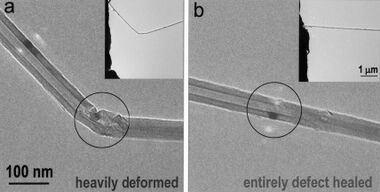Physics:Boron nitride nanotube

Boron nitride nanotubes (BNNTs) are a polymorph of boron nitride. They were predicted in 1994[2] and experimentally discovered in 1995.[3] Structurally they are similar to the carbon nanotube, which are cylinders with sub-micrometer diameters and micrometer lengths, except that carbon atoms are alternately substituted by nitrogen and boron atoms. However, the properties of BN nanotubes are very different: whereas carbon nanotubes can be metallic or semiconducting depending on the rolling direction and radius, a BN nanotube is an electrical insulator with a bandgap of ~5.5 eV, basically independent of tube chirality and morphology.[4] In addition, a layered BN structure is much more thermally and chemically stable than a graphitic carbon structure.[5][6]
Synthesis


All well-established techniques of carbon nanotube growth, such as arc-discharge,[3][8] laser ablation[9][10] and chemical vapor deposition,[11] are used for mass-production of BN nanotubes at a tens of grams scale.[7] BN nanotubes can also be produced by ball milling of amorphous boron, mixed with a catalyst (iron powder), under NH3 atmosphere. Subsequent annealing at ~1100 °C in nitrogen flow transforms most of the product into BN.[12][13] A high-temperature high-pressure method is also suitable for BN nanotube synthesis.[14]
Properties and potential applications

Electrical and field emission properties of BN nanotubes can be tuned by doping with gold atoms via sputtering of gold on the nanotubes.[12][15] Doping rare-earth atoms of europium turns a BN nanotube into a phosphor material emitting visible light under electron excitation.[13] Quantum dots formed from 3 nm gold particles spaced across the nanotubes exhibit the properties of field-effect transistors at room temperature.[16]
Like BN fibers, boron nitride nanotubes show promise for aerospace applications where integration of boron and in particular the light isotope of boron (10B) into structural materials improves both their strength and their radiation-shielding properties; the improvement is due to strong neutron absorption by 10B. Such 10BN materials are of particular theoretical value as composite structural materials in future manned interplanetary spacecraft, where absorption-shielding from cosmic ray spallation neutrons is expected to be a particular asset in light construction materials.[17]
Toxicological investigations on BNNTs conducted in the 2010s seem to show that the enhanced chemical inertia of BN nanotubes favors biocompatibility. As a result, their use in the biomedical field was suggested both as nanocarriers and as nanotransducers.[18]
BN nanotubes have also shown potential in certain cancer treatments.[19][clarification needed]
References
- ↑ Golberg, Dmitri; Costa, Pedro M. F. J.; Mitome, Masanori; Bando, Yoshio (2009). "Properties and engineering of individual inorganic nanotubes in a transmission electron microscope". Journal of Materials Chemistry 19 (7): 909. doi:10.1039/B814607A.
- ↑ Rubio, A. (1994). "Theory of Graphitic Boron Nitride Nanotubes". Physical Review B 49 (7): 5081. doi:10.1103/PhysRevB.49.5081. Bibcode: 1994PhRvB..49.5081R.
- ↑ 3.0 3.1 Chopra, N. G. (1995). "Boron Nitride Nanotubes". Science 269 (5226): 966–7. doi:10.1126/science.269.5226.966. PMID 17807732. Bibcode: 1995Sci...269..966C.
- ↑ Blase, X. (1994). "Stability and Band Gap Constancy of Boron Nitride Nanotubes". Europhysics Letters (EPL) 28 (5): 335. doi:10.1209/0295-5075/28/5/007. Bibcode: 1994EL.....28..335B.
- ↑ Wei-Qiang Han (2002). "Transformation of BxCyNz Nanotubes to Pure BN Nanotubes". Applied Physics Letters 81 (6): 1110. doi:10.1063/1.1498494. Bibcode: 2002ApPhL..81.1110H. http://www.glue.umd.edu/~cumings/PDF%20Publications/15.APL81han.pdf.
- ↑ Golberg, D.; Bando, Y.; Tang, C.C.; Zhi, C.Y. (2007). "Boron Nitride Nanotubes". Advanced Materials 19 (18): 2413. doi:10.1002/adma.200700179.
- ↑ 7.0 7.1 7.2 7.3 Kim, Keun Su; Jakubinek, Michael B.; Martinez-Rubi, Yadienka; Ashrafi, Behnam; Guan, Jingwen; O'Neill, K.; Plunkett, Mark; Hrdina, Amy et al. (2015). "Polymer nanocomposites from free-standing, macroscopic boron nitride nanotube assemblies". RSC Adv 5 (51): 41186. doi:10.1039/C5RA02988K.
- ↑ Cumings, J. (2000). "Mass-Production of Boron Nitride Double-Wall Nanotubes and Nanococoons". Chemical Physics Letters 316 (3–4): 211. doi:10.1016/S0009-2614(99)01277-4. Bibcode: 2000CPL...316..211C.
- ↑ Golberg, D. (1996). "Nanotubes in Boron Nitride Laser Heated at High Pressure". Applied Physics Letters 69 (14): 2045. doi:10.1063/1.116874. Bibcode: 1996ApPhL..69.2045G.
- ↑ Yu, D. P. (1998). "Synthesis of Boron Nitride Nanotubes by Means of Excimer Laser Ablation at High Temperature". Applied Physics Letters 72 (16): 1966. doi:10.1063/1.121236. Bibcode: 1998ApPhL..72.1966Y.
- ↑ Zhi, C. (2005). "Effective Precursor for High Yield Synthesis of Pure BN Nanotubes". Solid State Communications 135: 67. doi:10.1016/j.ssc.2005.03.062. Bibcode: 2005SSCom.135...67Z.
- ↑ 12.0 12.1 Chen, H. (2008). "Nano Au-Decorated Boron Nitride Nanotubes: Conductance Modification and Field-Emission Enhancement". Applied Physics Letters 92 (24): 243105. doi:10.1063/1.2943653. Bibcode: 2008ApPhL..92x3105C. Archived from the original on 2011-07-20. https://web.archive.org/web/20110720132612/http://wwwrsphysse.anu.edu.au/nanotube/pdf/aubnntapl08.pdf.
- ↑ 13.0 13.1 Chen, H. (2007). "Eu-Doped Boron Nitride Nanotubes as a Nanometer-Sized Visible-Light Source". Advanced Materials 19 (14): 1845. doi:10.1002/adma.200700493. Archived from the original on 2011-07-20. https://web.archive.org/web/20110720132706/http://wwwrsphysse.anu.edu.au/nanotube/pdf/Eu-BNNTs.pdf.
- ↑ Smith, Michael W; Jordan, Kevin C; Park, Cheol; Kim, Jae-Woo; Lillehei, Peter T; Crooks, Roy; Harrison, Joycelyn S (16 December 2009). "Very long single- and few-walled boron nitride nanotubes via the pressurized vapor/condenser method". Nanotechnology 20 (50): 505604. doi:10.1088/0957-4484/20/50/505604. PMID 19907071. Bibcode: 2009Nanot..20X5604S.
- ↑ Chen, Y. (2008). "Au Doped BN Nanotubes with Tunable Conductivity". Nano 2 (6): 367. doi:10.1142/S1793292007000702.
- ↑ Lee, C. H.; Qin, S.; Savaikar, M. A.; Wang, J.; Hao, B.; Zhang, D.; Banyai, D.; Jaszczak, J. A. et al. (2013). "Room-Temperature Tunneling Behavior of Boron Nitride Nanotubes Functionalized with Gold Quantum Dots". Advanced Materials 25 (33): 4544. doi:10.1002/adma.201301339. PMID 23775671.
- ↑ Yu, J. (2006). "Isotopically Enriched 10BN Nanotubes". Advanced Materials 18 (16): 2157. doi:10.1002/adma.200600231. Archived from the original on 2011-07-17. https://web.archive.org/web/20110717020530/http://www.rsphysse.anu.edu.au/nanotube/pdf/B10Nnanotubes.pdf.
- ↑ Ciofani, Gianni; Danti, Serena; Genchi, Giada Graziana; Mazzolai, Barbara; Mattoli, Virgilio (2013-05-27). "Boron Nitride Nanotubes: Biocompatibility and Potential Spill-Over in Nanomedicine". Small 9 (9-10): 1672–1685. doi:10.1002/smll.201201315. http://onlinelibrary.wiley.com/doi/10.1002/smll.201201315/full.
- ↑ Zhong, J; Dai, L.C. (2012). "Targeting Liposomal Nanomedicine to Cancer Therapy". Technology in Cancer Research & Treatment. doi:10.7785/tcrt.2012.500259.

